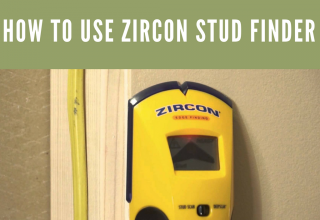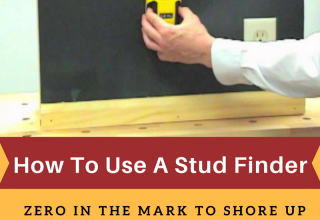 Drywall or lath for plaster walls hinge on studs or boards for framing support. Studs have a 16’’ to 24’’ spacing measured from midpoint to midpoint along a wall and stretch between the floor and ceiling. Hanging a cabinet, shelf and portraits with fasteners nailed directly into wall studs keeps them sturdily attached.
Drywall or lath for plaster walls hinge on studs or boards for framing support. Studs have a 16’’ to 24’’ spacing measured from midpoint to midpoint along a wall and stretch between the floor and ceiling. Hanging a cabinet, shelf and portraits with fasteners nailed directly into wall studs keeps them sturdily attached.
Drywall edges fasten over studs which create shadows of a tape joint, nail or screws. Use a glowing beam of light to illuminate the surface at a flat angle, outline of drywall joints and fasteners nestled at a stud. You can also resort to the old bag of handyman tricks like tapping with a hammer to hone in the edge of a stud.
Things To Consider About How To Find Studs In Drywall:
1. Detect One & Use A Tape Measure
If you pinpoint a stud, measure to the edge in 16’’ increments to home in the edge and center of neighboring studs.
The measurement of 16’’ from the midpoint and spacing will vary due to windows and doors. Carpenter tape measures come with 16’’ increments marked in red for more convenience.
The technique gets you to the estimated region hosting the adjacent stud; you need pinpoint-precision before whacking nails or drilling.
Use a small finishing nail drilled just above the baseboard molding via the drywall into the stud. Where the nail eats into the wood, you have verified the stud’s location.
2. Switches, Outlets, Windows & Doors
Windows and door spaces will always possess studs along the edges. Most have dual doubled-up studs known as sister or king stud to make the spaces ultra-sturdy.
You can always locate a stud above or below windows or doors.
Probe electrical switches and outlets as they mount on the edge of studs. Once you pull out the cover, you will see the side of the unit where the stud lies for supporting screws.
Measure a minimum of ¾’’ away from the unit to pin down the midpoint of the stud. You can resort to the knock and pin test to find out the stud’s breadth. Studs lie at 16’’ intervals on any side of the outlet or switch.
3. Instincts and Detective Trails
- Scour the interior trim like baseboard and crown molding fastened onto studs. You can hit the mark if you trace tiny dimples in the trim. The nail crevices stashed with caulk or painted over after the attachment of the trim remain vivid if you examine closely.
- Tap or knock the wall gently with a hammer to listen where a stud exists. A stud-less region will produce a low, hollow noise. A site hosting a stud will generate a higher, more robust sound.
- Drive a thin finish nail or smaller drill bit into the wall; you may even pinpoint the wooden fragments on the drill bit once you hit the stud.
4. Drywall Stud Navigation Easier than Other Materials
- Drywall offers the easiest of the typical wall finishes you can cut into and steer clear of studs, joists, and fire blocks.
- Drywall has a thinner and more resonant seam, which makes stud finding easy duck soup.
- Drywall exposes slight nail depressions; they become visible with a flashlight.
- Cracks, nail pops, and layers become visible on walls or ceilings finished with drywall due to the natural expansion or contraction of framing studs.
- You can easily knock screws of 1 ¼’’ or less to access the stud beneath the drywall. You can also home in onto studs with ½’’ drill to hit the wood.
5. Affordable Magnetic Stud Finders Will Do the Job
- With drywalls, you can scan across the surface to attract a buried screw or nail. They don’t locate the stud but the metal fasteners that secure the wallboard to the framing beams.
- You can detect the region of metallic nails and screw heads used to fix the drywall to the studs.
- Most magnetic stud finders have a notched, cone and v-shaped base for convenient and accurate marking after you locate one stud.
- If you have drywall with fasteners not deeply ensconced in the wall, a magnetic and low-cost stud sensor will locate the target at the drop of a hat.
6. Pinpoint-Accurate Electronic Stud Finders
- Electronic sensors help you pinpoint the wall studs and other targets in and around the layers. You can hone in the edge, center and hosting site as well as multiple targets simultaneously.
- Multiple sensor plates determine the pinpoint location, thickness and the center. Instant stud detectors also show studs-free regions in case you want to steer clear of a support beam.
- You can nail down the location of a metal fastener as well as wood studs, window and door framing.
- Electronic stud sensors have an improved accuracy range and detect studs embedded in drywall deeply. They also expose live wire up to or beyond 2”. You can also scan for wood, metal or live wires.
7. Why Find Studs in Drywall for Renovation?
- To nail bulky and heavy objects that require support for their weight directly into a fastener
- Attaching heavy items directly to drywall’s fibrous seams leaves surface exposed to the strain causing them to fall off
- Pinpointing studs offers a secure and sturdier hinging point to nail or screw directly
- Failing to accurately nail down a stud will jeopardize your precious items and leave you knocking through or bulldozing walls ruining structures
- Homes with standard model drywall specifications allow you to home in onto studs with a tape measure, flashlight, magnetic stud sensor and nail
- Multi-scanner and advanced stud-finding devices piece the wall for live AC wiring, rebar, ferrous and non-ferrous metals and other components you need to avoid
8. Stud-Foraging Tips & Cues
Most homes feature a 16” on-center stud, which means an adjacent one lies at the next 16” increment.
However, some external basement walls design includes 2×2’s as they can securely shore up the drywall
To use a stud finder, use a tape measure to highlight a minimum of three studs in an array, and then compute the distances between the targets. If the studs have equidistant measurements, it gives you an acid test
You can rely on a single stud to mount a sizable TV and other bulky object using two extra-large bolts in the midpoint of the snap reinforcements into the drywall render steady and sturdy support
Final Verdict
Our in-depth how to find studs in drywall guide will feed into your quest for information on safe and secure anchorage points. You won’t bark the wrong tree or search for the needle in the haystack armed with these detective cues and tricks.
If you own a stud finder, it’s a breeze to nail down fasteners for mounting heavy and permanent structures like TVs, wall shelves and cabinets. Advanced electronic stud finders can pinpoint other objects like water pipes, live AC electrical wiring, rebar and other targets.
They also boast digital LCD screens, LEDs and audio beeps to indicate a stud clearly with supportive data. Drywall layers create a red herring in your probe making high-precision, hand-held and multi-scanner tools essential.

















Leave a Reply